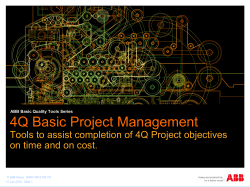
PROJECT MANAGEMENT CPM/PERT V P B Chakravarthi . K Abhijeet Kumar
PROJECT MANAGEMENT CPM/PERT V P B Chakravarthi . K Abhijeet Kumar Project “A project is a series of activities directed to accomplishment of a desired objective.” Plan your work first…..then work your plan Network analysis Introduction Network analysis is the general name given to certain specific techniques which can be used for the planning, management and control of projects. One definition of a project: “A project is a temporary endeavour undertaken to create a "unique" product or service” History Developed in 1950’s CPM by DuPont for chemical plants PERT by U.S. Navy for Polaris missile CPM was developed by Du Pont and the emphasis was on the trade-off between the cost of the project and its overall completion time (e.g. for certain activities it may be possible to decrease their completion times by spending more money how does this affect the overall completion time of the project?) PERT was developed by the US Navy for the planning and control of the Polaris missile program and the emphasis was on completing the program in the shortest possible time. In addition PERT had the ability to cope with uncertain activity completion times (e.g. for a particular activity the most likely completion time is 4 weeks but it could be anywhere between 3 weeks and 8 weeks). CPM - Critical Path Method Definition: In CPM activities are shown as a network of precedence relationships using activity-on-node network construction – Single estimate of activity time – Deterministic activity times USED IN : Production management - for the jobs of repetitive in nature where the activity time estimates can be predicted with considerable certainty due to the existence of past experience. PERT Project Evaluation & Review Techniques Definition: In PERT activities are shown as a network of precedence relationships using activity-on-arrow network construction – Multiple time estimates – Probabilistic activity times USED IN : Project management - for non-repetitive jobs (research and development work), where the time and cost estimates tend to be quite uncertain. This technique uses probabilistic time estimates. Gantt chart Originated by H.L.Gantt in 1918 Advantages Limitations - Gantt charts are quite commonly used. They provide an easy graphical representation of when activities (might) take place. - Do not clearly indicate details regarding the progress of activities - Do not give a clear indication of interrelation ship between the separate activities CPM/PERT These deficiencies can be eliminated to a large extent by showing the interdependence of various activities by means of connecting arrows called network technique. Overtime CPM and PERT became one technique ADVANTAGES: – Precedence relationships – large projects – more efficient The Project Network Use of nodes and arrows Arrows An arrow leads from tail to head directionally – Indicate ACTIVITY, a time consuming effort that is required to perform a part of the work. Nodes A node is represented by a circle - Indicate EVENT, a point in time where one or more activities start and/or finish. Activity on Node & Activity on Arrow Activity on Node Activity on Arrow - A completion of an activity is represented by a node - An arrow represents a task, while a node is the completion of a task - Arrows represent order of events Activity Slack Each event has two important times associated with it : - Earliest time , Te , which is a calendar time when a event can occur when all the predecessor events completed at the earliest possible times - Latest time , TL , which is the latest time the event can occur with out delaying the subsequent events and completion of project. Difference between the latest time and the earliest time of an event is the slack time for that event Positive slack : Slack is the amount of time an event can be delayed without delaying the project completion Critical Path Is that the sequence of activities and events where there is no “slack” i.e.. Zero slack Longest path through a network minimum project completion time Benefits of CPM/PERT Useful at many stages of project management Mathematically simple Give critical path and slack time Provide project documentation Useful in monitoring costs Questions Answered by CPM & PERT Completion date? On Schedule? Within Budget? Critical Activities? How can the project be finished early at the least cost? example Illustration of network analysis of a minor redesign of a product and its associated packaging. The key question is: How long will it take to complete this project ? For clarity, this list is kept to a minimum by specifying only immediate relationships, that is relationships involving activities that "occur near to each other in time". Before starting any of the above activity, the questions asked would be •"What activities must be finished before this activity can start" •could we complete this project in 30 weeks? •could we complete this project in 2 weeks? One answer could be, if we first do activity 1, then activity 2, then activity 3, ...., then activity 10, then activity 11 and the project would then take the sum of the activity completion times, 30 weeks. “What is the minimum possible time in which we can complete this project ? “ We shall see below how the network analysis diagram/picture we construct helps us to answer this question. CRITICAL PATH TAKES 24 WEEKS FOR THE COMPLETION OF THE PROJECT Packages are available to determine the shortest path and other relevant information. Data entry window Output of the package Limitations to CPM/PERT Clearly defined, independent and stable activities Specified precedence relationships Over emphasis on critical paths Thank you
© Copyright 2025





















